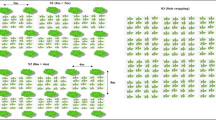Abstract
The adverse effects of forest clearing on crop yield have often been directly ascribed to decline in soil fertility. However, the effect of various forest clearing methods on crop nutrient uptake as reflected by the content in the leaf tissues has been the subject of few scientific investigations. A study to determine the effect of forest clearing on nutrient content of some arable crops was, therefore, carried out in the tropical rainforest of south-western Nigeria. Three forest clearing methods—mechanical, semi-mechanical and manual clearing—were used, while maize, cowpea, and cassava were the test crops. Nutrient content in the tissues of these crops was assessed by sampling maize ear leaves at silking, youngest mature leaves (YML) of cowpea at flowering and YML of 3-month-old cassava for analysis. Correlation analysis was carried out to establish the relationship between nutrient content and crop yield. The method of forest clearing had no significant effect on the nutrient content of maize and cowpea during the first cropping cycle. However, nutrient content of maize in the manually cleared plots was higher than those in the semi- and mechanically cleared plots for all elements analyzed except Mg. Nitrogen content of cowpea was much higher than that of maize. Except for P and K, the nutrient content of cassava was not markedly different among the forest clearing methods. Calcium and P content in the leaves of maize and cassava varied inversely with their levels in the soil, implying that crop uptake could have accounted for the differences in their availability within the soil. Nitrogen, P and K had significant positive correlations with maize yield (r = 0.77, 0.89, and 0.71). Potassium content also had significant positive correlation with cassava root yield (r = 0.69). This is not surprising because compared with other crops, cassava requires large amounts of K for starch formation and root development. It is concluded that differences observed in crop yields under different forest clearing methods are a function of nutrient uptake and availability within the soil. However, the uptake of some nutrients does not seem to be determined by the level of soil availability alone.
Similar content being viewed by others
Literature cited
Agboola, A.A. and Ogunkunle, A.O. (1993) Site characterization at Epemakinde, Ondo State, Nigeria. Technical report on land development for sustainable agriculture in Africa. IBSRAM/AFRICALAND Network. No. 5. 131pp, Bangkok, Thailand, 120–131.
Bray, R.H. and Kurtz, L.T. (1945) Determination of total, organic and available forms of phosphorus in soils. Soil Sci. 59: 39–45.
Eaglesham, R.J., Minchin, F.R., Summerfield, R.J., Dart, P.J., Huxley, P.A., and Day, J.M. (1977) Nitrogen nutrition of cowpea (Vigna unguiculata) 111: Distribution of nitrogen within effectively nodulated plants. Exp. Agric. 13: 369–380.
Eneji, A.E. (1997) Effect of land clearing methods on soil organic matter, nutrient status and crop yield in soils of Epemakinde, Southwestern Nigeria. 244pp, Ph.D. thesis, University of Ibadan, Nigeria.
Eneji, A.E., Aiyelari, E.A., Agboola, A.A., Ogunkunle, A.O., Akinbola, G.E., Omueti, J.A.I., and Babalola, O. (1995) Effect of land clearing methods on some soil properties and crop yield in the forest zone of South-western Nigeria. Afr. Soils 26: 345–352.
Eneji, A.E., Aiyelari, E.A., and Agboola, A.A. (1997a) Influence of forest clearing methods on weed incidence and maize yield at Epemakinde, South-western Nigeria. Niger. J. Weed Sci. 10: 21–26.
Eneji, A.E., Aiyelari, E.A., Agboola, A.A., Kutu, F.R., Ndaeyo, N.U., and Akinbola, G.E. (1997b) Preliminary investigations of the effect of bush clearing methods on soil nutrient status. J. Trop. For. Resour. 13(1): 16–26.
Escano, C.R., Jones, C.A., and Uehera, G. (1981) Nutrient diagnosis in corn grown on hydric Dystrandepts 1: Optimum tissue nutrient concentrations. Soil Sci. Soc. Am. J. 45: 1135–1139.
Howler, R.H. and Cadavid, L.F. (1983) Accumulation and distribution of dry matter and nutrients during a 12 month growth cycle of cassava. Field Crops Res. 7: 123–139.
IBSRAM (International Board for Soil Research and Management) (1994) Methodological guidelines for IBSRAM soil management Networks, 2nd ed. 243pp, IBSRAM, Bangkok.
Jackson, M.L. (1962) Soil chemical analysis. 498pp, Prentice Hall, New York.
Jones, J.B. Jr. (1967) Interpretation of plant analysis for several crops.In Soil testing and plant analysis Part 2. Soil Science Society of America Special publication Series No. 2. Walsh, L.M. and Beaton, J.B. (ed.), Soil Society of America, Madison, 40–58.
Kayode, G.O. and Agboola, A.A. (1985) Macro and micronutrient effects on the yield and nutrient concentration of maize (Zea mays) in Southern Nigeria. Plant Soil 63: 165–179.
Kintomo, A.A. (1992) The use of shrub legume alleys for soil fertility maintenance in a cassava-maize intercrop. 218pp, Ph.D. thesis, University of Ibadan, Nigeria.
Lal, R. (1976) No-tillage effects on soil properties under different crops in Western Nigeria. Soil Sci. Soc. Am. J. 40: 762–768.
Lal, R. (1992) Tropical agricultural hydrology and sustainability of agricultural systems: A ten year watershed management project in Southwestern Nigeria. 303pp, Ohio State University Printing Services, Columbus.
Melsted, S.W., Motto, H.L., and Peck, T.R. (1969) Critical plant nutrition composition values useful in interpreting plant analysis data. Agron. J. 61: 17–20.
Author information
Authors and Affiliations
Additional information
This study was supported with a research grant from the International Foundation for Science (IFS), Sweden.
About this article
Cite this article
Eneji, A.E., Ayade, B.B., Oko, B.F.D. et al. Influence of forest clearing methods on nutrient uptake of some tropical food crops. J For Res 6, 31–35 (2001). https://doi.org/10.1007/BF02762719
Accepted:
Issue Date:
DOI: https://doi.org/10.1007/BF02762719




